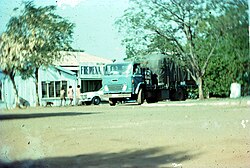Morris FF
| Morris / Austin FF / FH / FJ 45 / FJ |
|
|---|---|
| Manufacturer: | British Motor Corporation |
| Production period: | 1958-1970 |
| Previous model: | Morris FE / Austin S301 / S401 / S501 |
| Successor: | Leyland pilot |
The Morris FF / FH and Austin 45 was a forward control truck of the British Motor Corporation , which was offered as the successor to the heavier versions of the Morris FE / Austin S301 / S401 / S501 from 1958, while the lighter versions from 1959 onwards by the Morris FG / Austin FG were replaced. After a revision, the model series was marketed as the Morris / Austin FJ and from 1968 to 1970 as a BMC pilot . The model was replaced by the Leyland Pilot through the merger of BMC with Leyland Motors to form the British Leyland Motor Corporation .
Morris FF / Austin 45 1958–1961, Morris FH 1961–1964
| Morris FF / FH Austin 45 |
|
|---|---|
| Image does not exist | |
| Production period: | 1958-1964 |
| Engines: |
Petrol engine : 3.9 liters Diesel engines : 5.1 liters 5.7 liters |
The Morris FF / Austin 45 started in 1958 as the successor to the Morris FE / Austin S301 / S401 / S501 in its highest payload version of 5 tons. Unlike this one, it was not only available with 5 tons, but also with 7 tons and 8 tons of payload. However, it was not a completely new design, but the chassis and the lower part of the cab were taken over from the Morris FE. Now there was a modern one-piece windshield instead of the old-fashioned two-piece FE. In 1961 there was a revision to the Morris FH with an identical driver's cab but a new chassis in order to accommodate the enlarged and revised 5.7 liter six-cylinder diesel engine, among other things. In addition to the flatbed trucks and tractor units available ex works , the chassis of the FF / FH and Austin 45 was converted by body builders into a wide variety of special vehicles. In addition to various emergency vehicles for the police and fire brigade , special models were also built for the British post office and the British military. The Scottish company Halmo Technik stretched the driver's cab especially for this purpose and created a double cab. For export to Asian countries, the chassis was also supplied with a bus body .
Morris FJ / Austin FJ 1964–1968, BMC pilot 1968–1970
| Morris FJ / Austin FJ BMC pilot |
|
|---|---|

|
|
| Production period: | 1964-1970 |
| Engines: |
Petrol engine : 3.9 liters Diesel engines : 5.1 liters 5.7 liters |
The Morris / Austin FJ replaced the FH in 1964 with a completely redesigned cab. The design was dominated by double headlights mounted one below the other with an oval grille. This design style was also applied to the later launched BMC 350 EA . There was now a tilting cab for improved engine access and other minor mechanical changes. Another innovation was a flat cabin floor, which allowed occupants to enter or leave the cabin from both sides, and a console in the roof area for stowing smaller items and installing a radio. In addition, there was now a 10 ton payload variant. A double cab and a chassis specially prepared for bus superstructures were now delivered from the factory, but the cab could not be tipped here. After some of the commercial vehicles had already been marketed for export as BMC, BMC decided to also introduce this on its home market in the United Kingdom . Thus the model series was only marketed as a BMC pilot in mid-1968 . Since BMC merged with Leyland Motors to form the British Leyland Motor Corporation in the same year , the model became a Leyland Pilot in 1970 .
